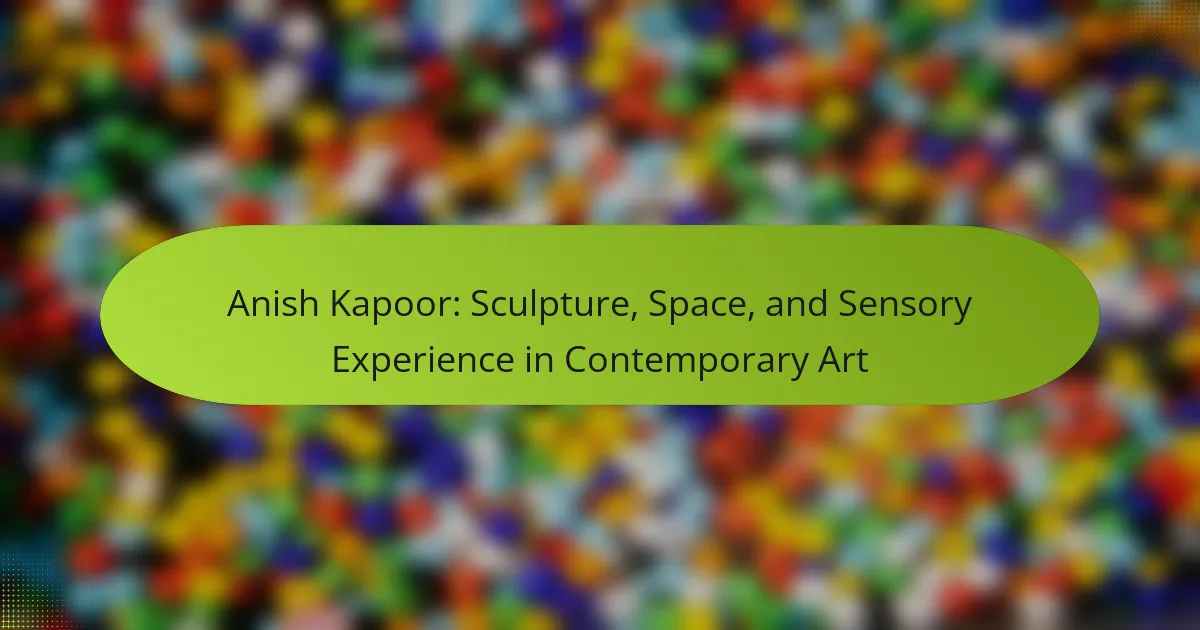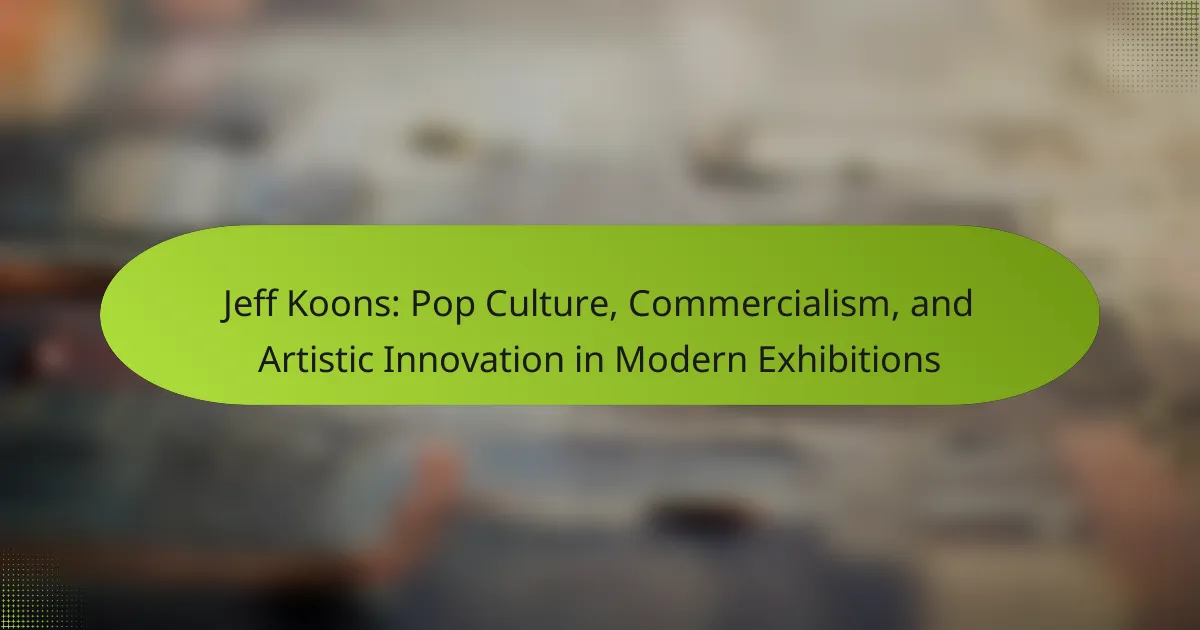Olafur Eliasson’s environmental art tackles climate change through immersive installations that engage audiences. His work emphasizes interactive elements, inviting participation and reflection on ecological issues. Key installations like “The Weather Project” showcase the interplay of light and nature, fostering a deeper connection to sustainability. Eliasson’s unique approach merges art with activism, inspiring collective responsibility for environmental awareness.
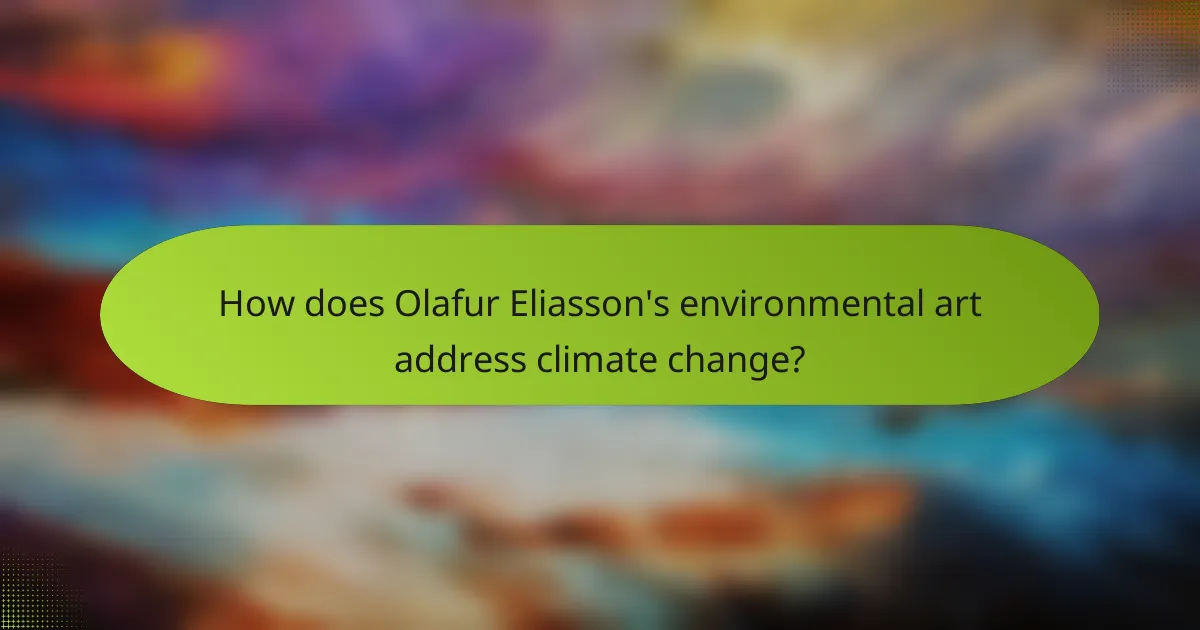
How does Olafur Eliasson’s environmental art address climate change?
Olafur Eliasson’s environmental art directly addresses climate change by creating immersive experiences that engage audiences with ecological issues. His installations, such as “The Weather Project,” highlight the relationship between nature and human perception. Through interactive elements, viewers become participants, fostering a deeper connection to climate action. Eliasson’s work emphasizes the urgency of environmental awareness, inspiring collective responsibility for sustainable practices. His unique approach merges art with activism, making climate change a tangible experience for all.
What are the key themes in Eliasson’s environmental installations?
Olafur Eliasson’s environmental installations emphasize themes of perception, climate awareness, and human interaction with nature. His work often incorporates light, water, and natural elements to create immersive experiences that provoke reflection on environmental issues. Eliasson engages audiences by inviting them to participate, fostering a sense of connection to their surroundings. Unique attributes of his installations include their adaptability to different environments and their ability to transform public spaces into interactive art. These themes encourage viewers to reconsider their relationship with the environment and the impact of climate change.
How do Eliasson’s works promote sustainability awareness?
Olafur Eliasson’s works promote sustainability awareness by engaging audiences through immersive experiences. His interactive installations often highlight climate change and environmental issues, encouraging viewers to reflect on their relationship with nature. For instance, the “Ice Watch” project used large blocks of ice to symbolize melting glaciers, creating a direct connection to global warming. Eliasson’s art fosters dialogue about sustainability, making complex topics accessible and emotionally resonant. By transforming public spaces into platforms for discussion, he inspires collective action toward environmental stewardship.
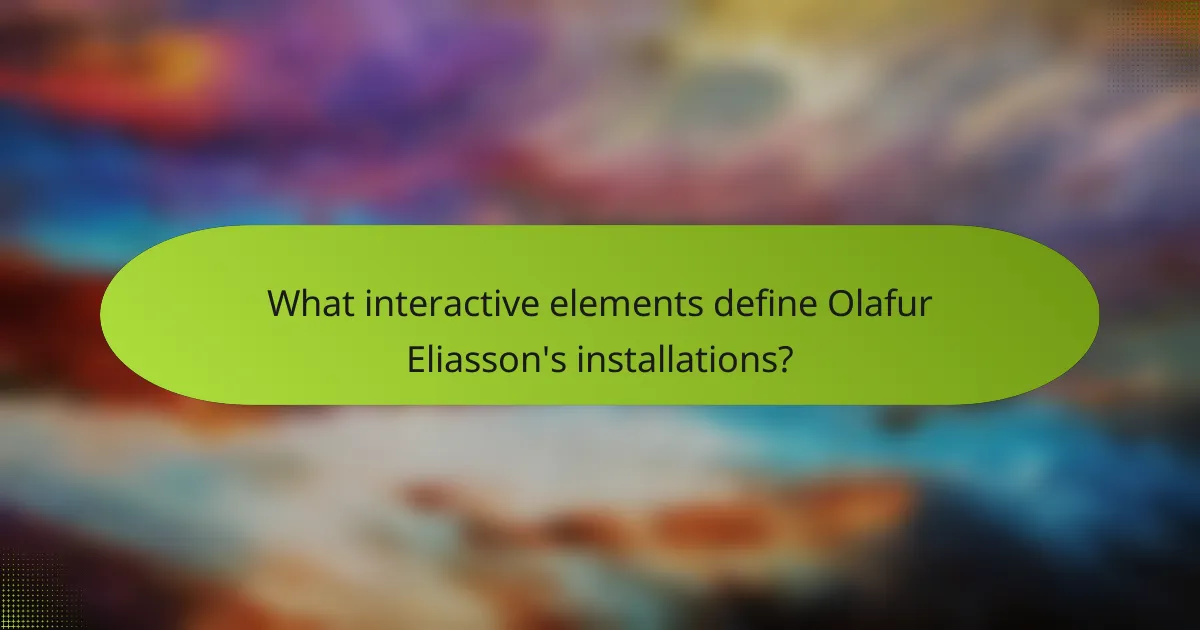
What interactive elements define Olafur Eliasson’s installations?
Olafur Eliasson’s installations are defined by immersive experiences, dynamic interactions, and sensory engagement. His work often incorporates light, water, and natural elements, inviting audience participation. Unique attributes include the use of shifting perspectives and environmental conditions, creating a dialogue between the artwork and viewers. Rarely, his installations may integrate technology, enhancing interactivity through digital means.
Which technologies enhance audience interaction in Eliasson’s art?
Technologies such as augmented reality, interactive projections, and immersive soundscapes enhance audience interaction in Eliasson’s art. These tools create dynamic experiences that engage viewers physically and emotionally. For instance, augmented reality allows participants to visualize environmental changes, fostering deeper connections with the artwork. Interactive projections respond to audience movements, making viewers co-creators of the experience. Immersive soundscapes further enrich the atmosphere, encouraging exploration and reflection. Together, these technologies transform passive observation into active participation, embodying Eliasson’s commitment to environmental awareness and engagement.
How does audience participation shape the experience of Eliasson’s works?
Audience participation significantly enhances the experience of Olafur Eliasson’s works by fostering a sense of connection and engagement. Interactive installations invite viewers to become active participants, transforming passive observation into immersive experiences. This engagement allows the audience to influence the artwork, creating a dynamic relationship between the art and its viewers. As a result, the meaning of the work evolves based on individual interactions, making each experience unique. Eliasson’s emphasis on environmental themes further deepens this connection, encouraging reflection on the relationship between humans and nature.
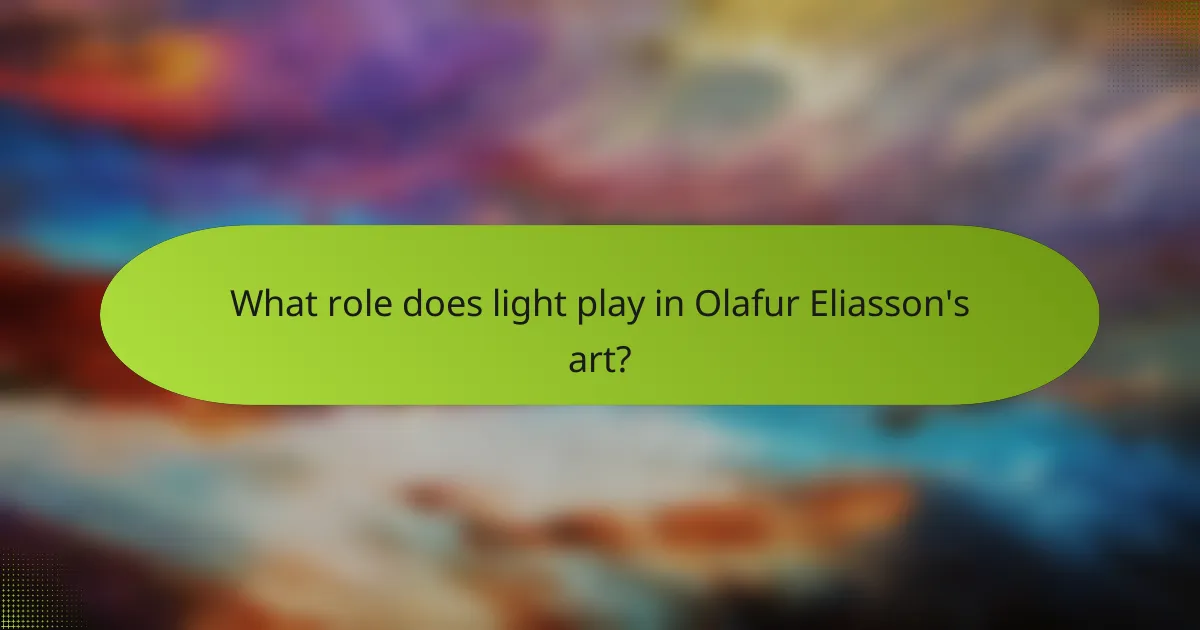
What role does light play in Olafur Eliasson’s art?
Light is central to Olafur Eliasson’s art, enhancing perception and interaction. He uses natural and artificial light to create immersive environments that engage viewers. For instance, installations like “The Weather Project” transform spaces through light manipulation, fostering a unique audience experience. Eliasson’s work emphasizes the relationship between light, space, and human perception, inviting reflection on environmental themes. His innovative use of light serves as a medium to explore perception and reality, making it a defining element of his artistic expression.
How does Eliasson manipulate natural light in his installations?
Olafur Eliasson skillfully manipulates natural light by using reflective surfaces and prisms to create immersive experiences. His installations often incorporate large windows or openings that allow sunlight to interact with the materials, transforming the space.
Eliasson’s unique approach emphasizes the viewer’s perception of light and shadow, altering their experience of the environment. For example, in “The Weather Project,” he used a giant sun made of artificial light to explore the relationship between natural and artificial illumination.
Eliasson’s installations often change throughout the day as the quality of light shifts, inviting audience engagement. This dynamic interaction encourages viewers to reflect on their relationship with nature and the environment.
What are the psychological effects of light in Eliasson’s artworks?
Olafur Eliasson’s artworks evoke profound psychological effects through their innovative use of light. The interplay of light and space often alters viewers’ perceptions, enhancing emotional engagement and introspection.
Eliasson’s installations, such as “The Weather Project,” create immersive environments that encourage contemplation and a sense of collective experience. The dynamic quality of light can evoke feelings of warmth, tranquility, or even anxiety, depending on its intensity and color.
Moreover, the interactive nature of his art invites audience participation, fostering a sense of agency and connection. This engagement can lead to heightened awareness of one’s surroundings and an emotional response to the interplay of light and shadow.
Ultimately, Eliasson’s use of light serves not only as a visual element but also as a catalyst for psychological exploration, prompting viewers to reflect on their own experiences and emotions.
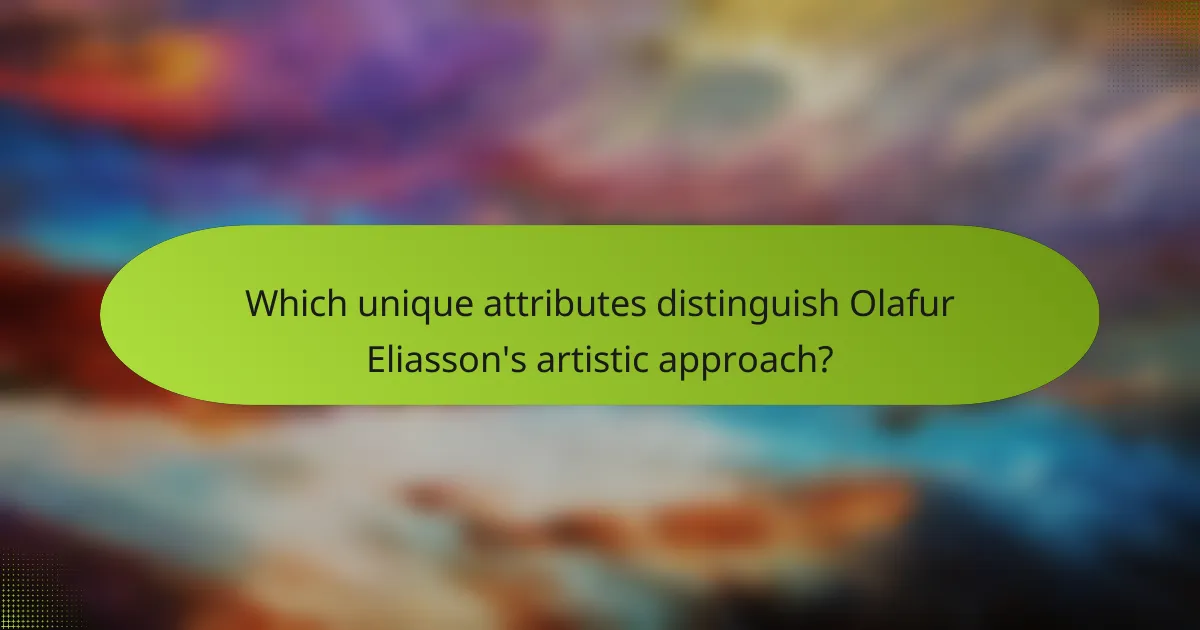
Which unique attributes distinguish Olafur Eliasson’s artistic approach?
Olafur Eliasson’s artistic approach is distinguished by his emphasis on environmental awareness, sensory experience, and audience participation. His unique attributes include the use of natural elements, innovative light manipulation, and the creation of immersive environments that engage viewers physically and emotionally. Eliasson often incorporates sustainable practices into his work, highlighting the relationship between art and ecology. Additionally, his installations encourage interaction, prompting audiences to reflect on their role within the environment.
How does Eliasson’s background influence his art?
Olafur Eliasson’s background significantly influences his art through his emphasis on environmental themes and interactive experiences. Growing up in Iceland, he developed a deep connection to nature, shaping his focus on light, water, and climate. His education in architecture and fine arts fosters innovative installations that engage audiences physically and emotionally. Eliasson often incorporates scientific principles, reflecting his commitment to sustainability and awareness of environmental issues. This unique blend of personal experience and academic foundation creates art that invites reflection on human interaction with the natural world.
What specific projects showcase Eliasson’s distinctive style?
Olafur Eliasson’s distinctive style is showcased in projects like “The Weather Project,” “Your Rainbow Panorama,” and “Ice Watch.” These installations emphasize environmental themes, audience interaction, and sensory experiences.
“The Weather Project” fills the Tate Modern’s Turbine Hall with an artificial sun, creating a unique atmosphere that invites reflection on climate change. “Your Rainbow Panorama” offers a circular walkway with colored glass, transforming perceptions of the surrounding cityscape. “Ice Watch” features large blocks of ice placed in urban settings, highlighting the urgency of climate awareness.
Eliasson’s work often combines art with scientific inquiry, encouraging viewers to engage with environmental issues through immersive experiences. His projects exemplify how art can provoke thought and inspire action regarding our planet’s future.
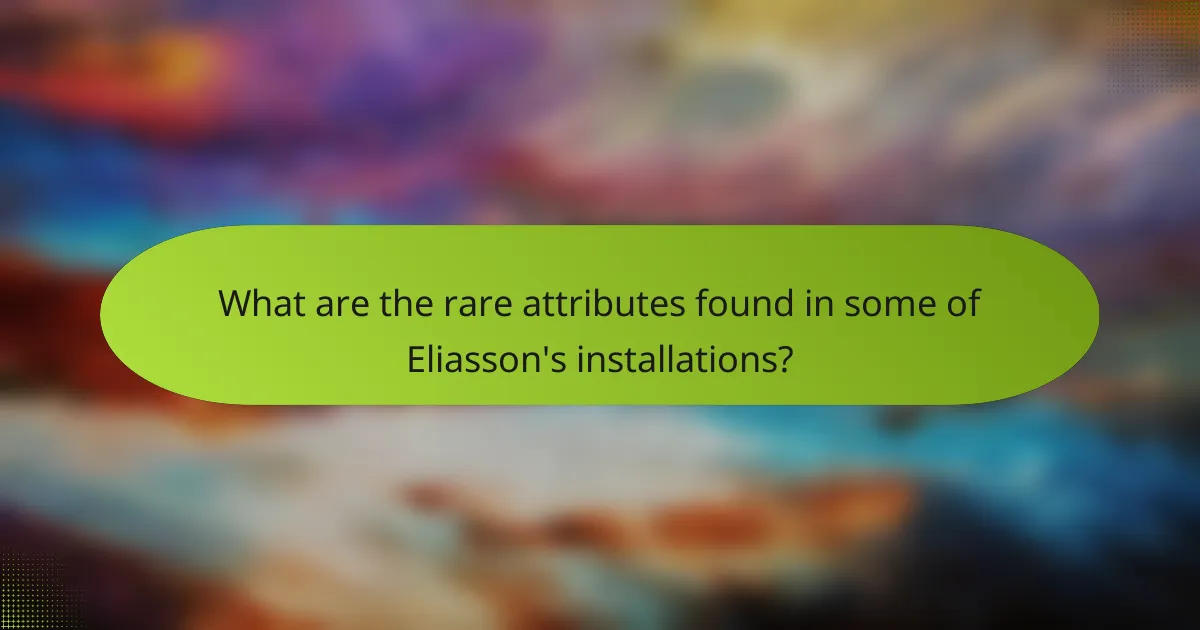
What are the rare attributes found in some of Eliasson’s installations?
Eliasson’s installations feature rare attributes such as ephemeral materials, immersive sensory experiences, and dynamic environmental interactions. These elements create unique connections between art and nature. For instance, his use of water in “The Weather Project” transforms space and perception. Additionally, the integration of light and shadow in installations like “Your uncertain shadow” evokes emotional responses, enhancing audience engagement.
Which installations feature uncommon materials or techniques?
Olafur Eliasson’s installations often incorporate uncommon materials and techniques, emphasizing environmental themes. His work “The Weather Project” utilizes mist and light to create an immersive atmosphere, while “Ice Watch” employs large blocks of ice from Greenland to raise awareness about climate change. These unique attributes enhance audience engagement through sensory experiences. Additionally, Eliasson’s use of reflective surfaces and interactive elements encourages participation, making art a dynamic dialogue between the viewer and the environment.
How do certain installations challenge conventional art perceptions?
Certain installations, like those by Olafur Eliasson, challenge conventional art perceptions by fostering audience interaction and environmental awareness. Eliasson’s works often blur the lines between art and nature, inviting viewers to engage physically and emotionally. For instance, his installation “The Weather Project” at the Tate Modern transformed the museum space into a simulated sunlit environment, prompting visitors to reflect on their relationship with nature. This immersive experience encourages a deeper connection with the artwork and challenges traditional passive viewing. By integrating elements like light, water, and climate, Eliasson reshapes how art is perceived, emphasizing participatory engagement over mere observation.
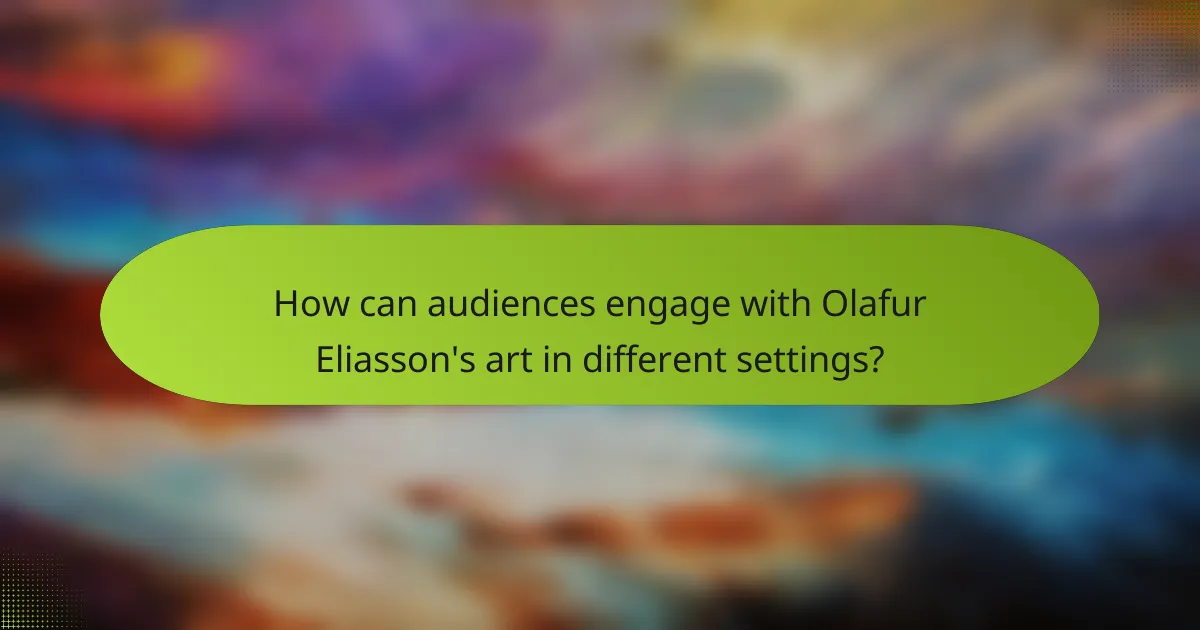
How can audiences engage with Olafur Eliasson’s art in different settings?
Audiences can engage with Olafur Eliasson’s art through immersive experiences, interactive installations, and site-specific projects. These settings encourage participation and reflection, fostering a deeper connection to environmental themes.
In galleries, Eliasson’s installations often invite viewers to interact physically and emotionally, creating a dialogue between the art and the audience. Outdoor installations, like “The Weather Project,” utilize natural elements to enhance engagement and provoke thought about climate change.
Public spaces serve as unique platforms for Eliasson’s work, allowing broader audiences to experience art outside traditional settings. His projects, such as “Your Rainbow Panorama,” transform urban landscapes and invite exploration.
Educational programs and workshops further deepen engagement, providing insights into Eliasson’s artistic process and environmental messages. These initiatives encourage audiences to reflect on their relationship with nature and inspire action toward sustainability.
What are the best practices for experiencing Eliasson’s installations?
To fully appreciate Olafur Eliasson’s installations, engage actively with the environment and embrace the sensory experience. First, visit during different times of day to observe changing light and atmosphere. Second, participate in guided tours to gain insights into the artistic intent. Third, take time to reflect in the space, allowing for personal interpretation. Fourth, interact with fellow visitors to share perspectives. Lastly, document your experience through sketches or notes to deepen your connection with the art.
What common mistakes should visitors avoid when engaging with his art?
Visitors should avoid distractions and preconceived notions when engaging with Olafur Eliasson’s art. Engaging fully requires open-mindedness and active participation. Common mistakes include not interacting with installations, overlooking the environmental themes, and failing to consider the emotional impact. Additionally, visitors often rush through experiences without reflecting on their personal connections to the art. Taking time to immerse oneself enhances appreciation and understanding.
